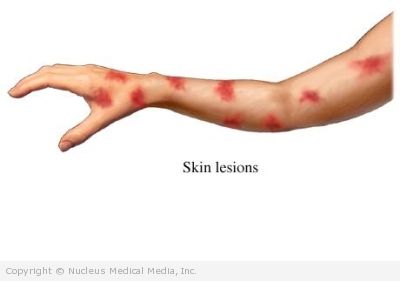Kaposi’s Sarcoma – Definition
Kaposi’s sarcoma (KS) is a form of cancer. It affects the blood vessels. It can cause lesions on the skin, mucus membranes, or internal organs. It occurs most commonly in the gastrointestinal tract and lungs.
Cancer occurs when cells in the body divide without control or order. If cells keep dividing uncontrollably, a mass of tissue forms. This is called a growth or tumor. The term cancer refers to malignant tumors. They can invade nearby tissue and spread to other parts of the body.
KS can be classified according to the group of people that it affects:
- Classic — usually affects men of Mediterranean descent
- Endemic — usually affects people living in equatorial Africa
- Transplant-related (acquired) — affects people who have received an organ transplant
- AIDS-related (epidemic) — affects people with AIDS
Kaposi’s Sarcoma – Causes
Most cases of KS occur in people with AIDS. In this group, studies have shown a strong link between KS and a sexually transmitted virus. The virus is called human herpes virus 8. These factors probably account for most cases. The virus also appears to be linked to classic and endemic KS.
Kaposi’s Sarcoma – Risk Factors
These factors increase your chance of developing KS:
- HIV infection
- Men who have sex with men, and women who have sex with bisexual men
- Drugs that suppress the immune system
- Tell your doctor if you have any of these risk factors.
Kaposi’s Sarcoma – Symptoms
The most common symptom is skin or mucus membrane lesions that:
- Appear as raised blotches or nodules
- Develop anywhere on the body
- Are purple, brown, red, or pink
- May cause swelling and pain
Other symptoms include:
- Internal bleeding (when lesions develop inside the body)
- Breathing problems (when lesions develop in the lungs)
Kaposi’s Sarcoma – Diagnosis
The doctor will ask about your symptoms and medical history. A physical exam will be done. If you have skin lesions, the doctor may base the diagnosis on this. If you have bleeding, pain, or weight loss, you may need more tests to find out if you have KS.
Tests may include:
- Biopsy — removal of a sample of tissue from a lesion to test for cancer cells
- CT scan — a type of x-ray that uses a computer to make pictures of structures inside the body
- Bronchoscopy — a thin, lighted tube inserted down the throat to examine the lungs and air passages
- Endoscopy — a thin, lighted tube inserted down the throat to examine the gastrointestinal tract
Your doctor may suspect you have KS if you have AIDS and your lymph nodes are swollen.
Kaposi’s Sarcoma – Treatment
Treatment depends on the type of KS. If KS is related to AIDS, treatment is focused on relieving pain. Treatments include:
Surgery
This involves the removal of KS lesions on the skin and mucus membranes. Surgery to remove internal lesions depends on:
- Size
- Location
- Symptoms
Because KS can bleed a lot after surgery, the doctor will try to remove the entire lesion with some normal tissue around it. This is to try to reduce bleeding.
Radiation Therapy
Radiation is used to kill cancer cells. This therapy is usually given once or in divided doses over 2-3 weeks. The number of treatments depend on the size and location of the lesions.
Antiretroviral Therapy
This therapy is used to combat HIV and restore immune function. In some patients, it may be very effective against KS.
Chemotherapy
Chemotherapy is the use of drugs to kill cancer cells. It may be given in many forms, including pill, injection, and via a catheter. The drugs enter the bloodstream and travel through the body killing mostly cancer cells. Some healthy cells are also killed. In some cases, the agents can be injected directly into a lesion.
Biological Therapy (Biological Response Modifier Therapy)
This is the use of medications or substances made by the body. They are used to increase or restore the body’s natural defenses against cancer.
Kaposi’s Sarcoma – Prevention
To prevent AIDS-related KS, take these steps to minimize your exposure to HIV:
- Abstain from sex. If you have sex, use a male latex condom.
- Do not share needles.
- Limit how many people you have sex with.
- Avoid sexual partners who have HIV or who use IV drugs.
- Avoid getting a transfusion of unscreened blood products.
- If you are a healthcare worker:
- Wear latex gloves and facial masks.
- Carefully handle and properly dispose of needles.
- Carefully follow universal precautions.
- If you live in a household with an HIV-infected person:
- Wear latex gloves if handling body fluids.
- Cover all cuts and sores with bandages. This includes cuts on you and the patient.
- Do not share personal hygiene items.
- Carefully handle and properly dispose of needles.

